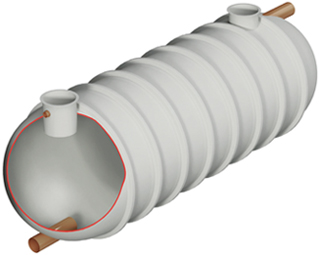If your building doesn’t have access to mains sewers, you’re probably going to be using a septic tank or a sewage treatment plant. Both of these things are similar and serve the same purpose, but to give you a better idea of the differences between a septic tank and a sewage treatment plant, we’ve put together this handy guide.
How does a septic tank work?
A septic tank is usually buried underground and is where sewage water from your property goes. Once in this tank, two things happen. Firstly, solid waste sinks to the bottom to become what is known as sludge. The second thing that happens is that oils will float to the top and create what is known as the surface scum.
This leaves only your wastewater – sometimes called effluent – behind. The effluent flows out of the tank via an outlet pipe, taking it into a specified drainage area. There are strict rules about where this water can go, as it needs to soak away in the ground which can cope and treat the water naturally. This usually involves needing a lot of distance from other water sources, properties and soakaways.
A septic tank has two chambers, both of which help the natural separation process of solids and oils before the water goes out of the tank.
How does a sewage treatment plant work?
Carrying out the same function as a septic tank, sewage treatment plants work a little differently to get the job done. The same two elements are separated out of the sewage water – sludge and oil – in an initial chamber, but the wastewater then moves to a second chamber where it is “treated”. This treatment involves the aeration of the water to promote the growth of good bacteria. This makes the effluent cleaner as it goes into the final settlement chamber. From here it can be released out of the chamber into nearby watercourses as opposed to a soakaway.
What are the key differences between septic tanks and sewage plants?
- The water from a sewage plant is cleaner than that which comes out of a septic tank.
You wouldn’t want to drink it, but it’s deemed safe enough to be reintroduced into
watercourses. Septic tank effluent has to be drained into a soakaway or drainage
field. - The regulations surrounding septic tanks are tighter (as of Jan 1st 2020) in terms of
where the effluent can exit. There are still regulations for sewage plants, but the
options are slightly better and less distance is needed for draining the effluent away. - A septic tank traditionally has two chambers, while a sewage plant is likely to have
three. - A sewage treatment plant requires electricity so that air can be circulated into the
water in the second chamber, something a septic tank doesn’t need. - A septic tank will likely need to be emptying more frequently than a sewage treatment
plant will – something to keep in mind for your property.
Here at Wildon UK, we’re experts when it comes to wastewater systems and treatment. We have a team of fully trained engineers on hand to offer expertise and advice, performing repairs, maintenance and even installation for both septic tanks and sewage treatment plants. Whether you need help with your existing system or you’re trying to find the right system for your property, simply contact us and we’ll be happy to assist wherever you are in the UK – all from our base of operations in Stoke-on-Trent in Staffordshire.










